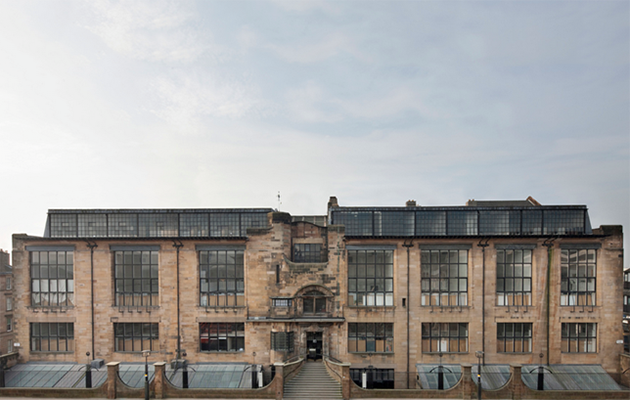
A second fire has almost completely destroyed the Glasgow School of Art, one of Charles Rennie Mackintosh’s most admired landmarks. Can digital technology help preserve the building and its legacy in the face of devastation, asks Rita Lobo
The Glasgow School of Art will be rebuilt and reinstated as a fully functional art school, says Tom Inns, the director. The announcement quashes speculation of a tear-down or change of use after a second fire devasted the building four years after the first destructive blaze.
The 2014 fire was contained to the east wing of the building. At the time firefighters managed to save up to 90% of the original 1899 building and the 1909 extensions – the building had been since been closed for an extensive programme of restoration costing £35m.
In June, a second blaze rippled through most of the Art Nouveau masterpiece, spreading not only to the library, but to every floor, and also to neighbouring buildings. It took 120 firefighters to control it and there are reports the building did not cease to smolder until well into the following evening.
The University of Glasgow, along with the Charles Rennie Mackintosh Society, the local and Scottish government and a host of philanthoropic entities, were at the cusp of completing the restoration of the building, and preparing it to re-open. After weeks of speculation over the fate of the building, Inns confirmed in an interview with The Guardian the 110-year -old landmark will be rebuilt: ‘There’s been a huge amount of speculation about what should happen with the site and quite rightly so, but from our point of view and that of the city of Glasgow, it is critically important that the building comes back as the Mackintosh building.’
The building is currently being dismantled, and there are still no estimates of cost or even how much of the original will be preserved in the rebuild.
The Glasgow School of Art case is not unique in history. After all the devastation of the built environment is nothing new: buildings that once defined their surroundings have crumbled in fires, natural disasters, or during war. Even entire cities like Berlin, Tokyo, and Warsaw have succumbed. In certain cases, landmarks are rebuilt, while at other times they are preserved in ruins as a reminder of tragedies that have befallen them. However, modern technology means that even destruction by fire doesn’t have to spell the end of the line for an edifice, as new technology offers more options in terms of rebuilding and preservation.
Glasgow School of Art is on fire beware those on suchihall street pic.twitter.com/lBNduZJeru
— KC (@CrossleyKieran) June 15, 2018
After the partial destruction of the UNESCO World Heritage site Palmyra in Syria, at the hands of ISIS, its famous arch was 3D printed by Dutch designers CONCR3DE, using the original stone material and based on photographs and surviving detailed plans. While it would be impossible to claim that the new arch is a piece of Palmyra itself, it has gone a long way towards preserving the legacy of the place.
There are, of course, ethical and philosophical factors to be considered when choosing to rebuild. Will a twice rebuilt Glasgow School of Art be Mackintosh’s original building or a mere copy? A 3D-printed building would certainly be considered a replica by many, what role can this technology have in recreating lost detailing when the building is put back together?
Building surveyors and conveyancing specialists already rely on 3D laser scanning – a powerful laser recording of field data that captures a site’s shapes and possibly its appearance then converts those conditions into a cloud of data points – but its application in conservation is developing rapidly. In fact, in the wake of the 2014 fire at the Glasgow School of Art, 3D laser scanning was used to determine the extent of the damage and inform the rebuild, and its example is leading the research in this field.
Inns said that thanks to detailed digital modelling carried out as part of the previous restoration work, specialists already have “an incredible insight into every corner of that building”, which will certainly help speed up the dismantling and future re-building process.
Whatever happens with tonight’s blaze, this is the Glasgow School Of Art I’m gonna remember. These utterly stunning details. pic.twitter.com/ZfZt6BPDi1
— nikki (@nikkidarling) June 16, 2018
Such technology is also under consideration for use in Syria, where years of civil war have razed countless historic cities to the ground. For the time being, 3D laser scanned images are primarily viewed on computer screens, the rapid advancements in virtual reality technology will soon mean that buildings will exist virtually and as more than just an image.
There is also the potential to simply rebuild the Art School in a conventional manner. The extensive research and planning work carried out for the original restoration post-2014, has proved that though costly, it is possible to rebuild. Such is the affection felt by Glaswegians for Mackintosh’s landmark that questions of authenticity might be set aside, as a faithful facsimile of a well-loved symbol will – at least for some – be preferential to no building at all.

















